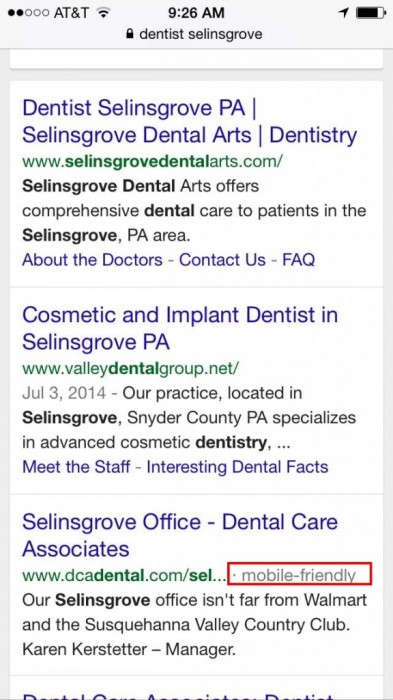 By the end of 2013 there were nearly more cell phones in the world than people. What does this mean? It means different things to different people. One of the financial facts that cannot be ignored is that 46% of all web searches are conducted through mobile devices, and 46% of 6.8 billion cell phones is a lot of mobile searching. That statistic should grab the attention of anyone in business that does not have a mobile strategy and a mobile friendly web-presence.
By the end of 2013 there were nearly more cell phones in the world than people. What does this mean? It means different things to different people. One of the financial facts that cannot be ignored is that 46% of all web searches are conducted through mobile devices, and 46% of 6.8 billion cell phones is a lot of mobile searching. That statistic should grab the attention of anyone in business that does not have a mobile strategy and a mobile friendly web-presence.
Problem of Inaccurate Information
According to a study ComScore released in April, 79% of mobile searches are for local information. If a user is looking for a local business, what happens if the information they find is not accurate? Usually they lose faith in either the place they are looking or the company that provides the solution they are searching for, or both. According to a recent survey, 73% of people lose trust in a business when they find incorrect information about them and 67% say they lose trust in the brand if they got lost driving or walking to that business due to incorrect information. Regardless of whether it is the brand / business’s fault or the directory that posted it, the importance of the accuracy of your business listing should be obvious. Google and other search engines get listing information from many sources. Including, you entering your own info, government sources, user-generated content (apps like FourSquare and Swarm) and data providers. That being said, it’s important that you have a way to monitor all of your listings accurately and that you can affect change to any incorrect listings in an efficient way. This will help part of optimizing your digital strategy on mobile devices, but there are also other considerations.
Mobile Searcher Frustrations
When a person does a web search using their phone or tablet, they will get many results with many options regarding a product or service they are searching for. The results of that web search, which could be conducted by a customer who wants to spend money and is searching for the best local Italian restaurant, or for great shoes, are ranked based on many factors, including whether or not the website is mobile friendly. When half of all web searches are conducted on mobile devices, it seems intuitively necessary to ensure that your website is mobile friendly.
The frustration for the user is when they search a website on their phone, and the website is not mobile friendly. Perhaps the formatting is wrong, so it is impossible to get the landing page on the mobile window correctly. Perhaps menu links and buttons are impossibly tiny for a normal person to click on. Most users will try another website rather than face the continued frustration of trying to maneuver around an ill-formatted website. What could be useful and ease many frustrations for the user would be a way to determine if a website was mobile friendly before trying to maneuver through a site.
Google’s Recommendations on Mobile Optimization
Google first took a stand on Mobile SEO Best Practices in June 2012 when they recommended the use of responsive web design. Further changes to their ranking algorithms have enforced the need for mobile friendly sites throughout the last 2 years. Most recently with the update nicknamed Pigeon, Google improved its distance and location ranking parameters, which directly affects improvements on local mobile search. According to Google, in the near future they will start demoting sites within mobile rankings that provide a poor user experience to smartphone searchers, starting with any sites that exhibit any of the common smartphone configuration errors. Designing a mobile-friendly website is now a necessity for every company, large and small, not only for the search ranking advantages but for the success of converting visitors to your goals in today’s on-demand, device-of-choice world. The other issue that must be addressed is the content strategy. A content strategy for responsive design comes down to a lot more than just design and layout. Developers, marketers and designers need to have an understanding of how their visitors are using their pages and what expectations they have for the content. This, together with design and layout considerations, should outline your mobile strategy.
Google Testing New Mobile Indicators
Google tested just such a way to determine if a website is designed for mobile devices or not. In recent tests, Google Search has included a label in the search results that will state whether or not a website is mobile friendly. If having 46% of all searches done on mobile devices wasn’t incentive enough, a label in Google should do the trick!
Although there are few facts about this “mobile friendly” label at this point, it will be important to people who have a web presence, but whose website isn’t formatted for mobile device users. Think about how important it can be to a company’s bottom line if users will or won’t visit their site simply because they know that the site does, or does not, support a mobile device view.
It appeared that including the mobile designation in the Google search results have been a limited test. Included are two screen shots that when we went back and checked, the results were gone. This is likely a Google test for something like 5% of the results. However, that doesn’t diminish the potential impact of on businesses depending on whether the search results state that the website is mobile friendly or not.
The first screenshot is of a search for a dentist in Selinsgrove, Pa. Of the three results displayed on the screen, only one shows that it is mobile friendly. A user suffering from a tremendous toothache and searching for a dentist on a mobile phone will probably choose the website that is mobile friendly. There are few difference in the description about the three dentists, but one website distinguishes itself from the rest — Dental Care Associates — because it is designated as a mobile-friendly site.

Image credit: Michael Johnston
The second screenshot is for dentists in Denver. Instead of a label that a site is mobile friendly, there is an icon of a mobile device. The icon may be more subtle, but it is still effective. You can see in this search that all but one website gets the mobile icon.

The potential impact is gigantic and we should be sharing it. On November 18, Google officially announced this mobile-friendly change to the search results page. In the post, Google says that this change will be rolling out over the next several weeks. They also give some advice on how they are grading for this designation to help you make the appropriate adjustments to your site.
Google Adds Mobile Usability Tools
On the heels of our findings of the mobile-friendly site indicators in mobile search, Google announced the addition of a tool for tracking your mobile usability issues in Webmaster Tools. The tool will show you the common usability issues with the mobile version of your site so that you can improve the mobile experience for your users. All indications point to this being another sign that mobile usability is coming to Google as a ranking signal.
What Now
Mobile phones have not only changed the way we live and communicate daily, they have also changed the way we think as a society. Consumers have experienced a shift in their mindset: They expect any desired information or service to be available, on any appropriate device, in context, at their moment of need. Technologies packed in mobile devices enable people not only to instantly consume but also to create content and maintain greater control in their everyday lives. Customers’ behaviors are becoming as sophisticated as their devices. Mobile has become the new digital hub. The obvious implications are that you must have a mobile component in your digital strategy. But it goes beyond this, as mobile is bridging the offline and online worlds. Marketers should focus on delivering useful experiences that meet the growing expectations of customers on their most intimate devices. The true meaning of mobile access is not about the devices and apps we use now but the change in attitudes they are creating in the minds of millions of customers and employees. This is the mobile mind shift. You need to prepare for it because it will change what customers expect and demand of your company.





 8055 E Tufts Ave Ste 240
8055 E Tufts Ave Ste 240




